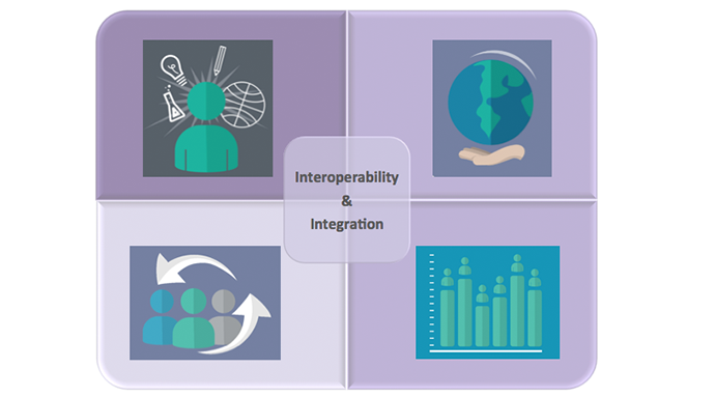Expectations for the Next Generation Digital Learning Environment
Topics

Educators often take advantage of educational technologies as they make the shifts in instruction, teacher roles, and learning experiences that next gen learning requires. Technology should not lead the design of learning, but when educators use it to personalize and enrich learning, it has the potential to accelerate mastery of critical content and skills by all students.
A Response to Bloggers' Comments
The Next Gen Digital Learning Environment report sparked a dialogue among several prominent bloggers, and now, we’d like to respond to some of the discussion that emerged since its publication.
In early May, EDUCAUSE published a white paper that summarized its research on the successor to the learning management system (LMS). We called this the next-generation digital learning environment (or NGDLE; a bit more on this acronym later in this post). The white paper is available here.
Our document sparked a dialogue among several prominent bloggers, and now, we’d like to take the opportunity to respond to some of the discussion that emerged since its publication.
To quickly summarize: the main idea of the white paper is that a single, über-application won’t be adequate to the task, given the diversity of post-secondary education. Hence the LMS successor needs to be a digital environment, built up as a confederation or mash-up of individual digital components, addressing the five core functional domains of interoperability, personalization, analytics, collaboration, and accessibility/universal design. To enable the confederation, we proposed a Lego metaphor, where the components adhere to create a coherent or interoperable digital environment, based on conformance to an NGDLE standard.
In a post from May 11, Tony Bates welcomes many of the points made in the paper, but mentioned reservations about what he sees as an overemphasis on standardization. Tony is uneasy that what we suggest in the white paper is “too much of a top-down approach.” First, he says, there is a question of who has the authority to set standards (“standards are all very well, but who will set these standards”). But he also seems to be saying that standardization is the wrong direction altogether: “We need actually to move away from the standardization of learning environments… just as we are able to start breaking away from rigid standardization EDUCAUSE wants to provide a digital educational environment based on standards.”
In fact, we are suggesting anything but a rigid or top-down approach. We’re not, for example, trying to dictate standards on how to conduct discussion forums or formative assessments. We’re thinking about the technical and other standards needed to enable the NGDLE components to snap together. We are imagining a time when instead of adopting a platform, you have the opportunity to assemble your platform/environment, at least in part, by using components. In this respect, we assert that standards, when used in the right proportions, are essential. We fully support the need to serve the diversity that characterizes higher education, which is why we made personalization and customization one of the key functional domains. It’s also why we use terms like “mash-up” and “confederation” to describe what we envision. But for that to work, there has to be some degree of standards that enable components to work together. As we say in the white paper, the balancing act is to support diversity while retaining technological and functional coherence that enables interoperability.
And we’re not just thinking about technical standards. We suggest that all five of the functional domains need to inform the development of any NGDLE components. Designers of component applications should be mindful of all five as they proceed. We are suggesting, for example, if accessibility and universal design should inform the design of all NGDLE components, and so should be part of a NGDLE standard. The importance of standards is not arriving at uniformity, but rather enabling diversity.
Tony’s comments are helpful since as they suggest that we should perhaps have said a bit more about NGDLE compliance, a concept we hint at but do not develop. We feel that the next step in this research is to explore this idea more concretely, to test whether it is a practical concept and if it is, what it might look like. Our suggestion is that if this idea has merit, it will greatly accelerate the arrival of the NGDLE, since it will result in components that all schools can selectively adopt and deploy in ways that support their own goals and opportunities.
Jon Dron at Athabasca University also made some comments in a recent post that appeared the day after Tony’s, and responds in part to his comments.
Like Tony, Jon appreciates some points made in the paper. He also advances some criticism, such as asserting that the white paper “simply reflects cutting edge practice (most of which has fully functional antecedents stretching back more than a decade), rather than looking to the pedagogical future as the title suggests.” He goes on to say: “it [the white paper] is a bit caught up with trends rather than deep patterns of change. I am particularly concerned that things like analytics, recommender systems and adaptive 'personalized' systems do have a role in that future, but maybe not the critical, transformative or ubiquitous one that evangelists claim for them.”
"There's a place for technologies such as analytics and adaptive applications, and the NGDLE needs to reflect that. But nowhere do we suggest that the NGDLE should be bound or defined by them."
In fact, we feel the vision for the NGDLE does indeed look to the future, envisioning a time when learners, instructors, and institutions can customize and personalize their digital environment to an unprecedented degree. This would seem to certainly open the door to “deep patterns of change.” In addition, the white paper is entirely agnostic with respect to whether analytics or adaptive technology will prove to be transformative or not. We make no such assertion; the white paper is not merely running with the trends. We actually quite agree with Jon that analytics in particular will have a role in the future. There is little doubt of that. The thrust of the idea in the white paper is that the scope of that role will need to be determined by institutions, faculty, and learners. We argue there’s a place for technologies such as analytics and adaptive applications, and the NGDLE needs to reflect that. But nowhere do we suggest that the NGDLE should be bound or defined by them.
Jon also thinks our Lego metaphor is not the right one: “We should be making tools that can be attached firmly to one another, not that conform to a preset set of shapes.” In the end, it’s probably not essential to debate in detail which metaphor is correct, as long as we agree, more or less, on the conceptual level. We agree completely that the key is that the NGDLE components “attach firmly to one another.”
As for the pieces themselves, the last time we looked, there is also a huge variety of Lego pieces. Want Spiderman, the Big Bang Theory characters, Liam Neeson, or Lionel Messi? You got it. But seriously: in most cases, NGDLE digital components would indeed come as “pieces” that you then snap into place. Perhaps where the Lego metaphor breaks down is that if the NGDLE pieces are open, then you can modify them or your can create your own pieces. In any event, we are not attached to the Lego metaphor, and if it is off the mark, we have no issue questing for another that better captures our thinking.
One final point. Jon Dron writes: “NGDLE is an appalling acronym!”
We actually agree with that assessment, even though its very ugliness and complexity does make it easier to search online for discussions about it. We would be happy to consider a more elegant and emotionally vibrant name.
Tell us what you think. We welcome Tony’s and Jon’s input as well as comments from other community members. We all have a stake in where this discussion takes us.




